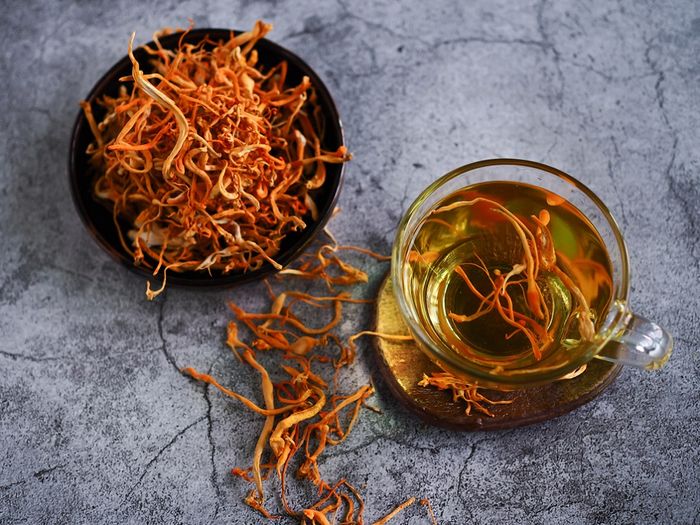Cordyceps Sinensis vs Cordyceps Militaris
Updated September 20, 2023.

Cordyceps is a type of functional mushroom that seems to promise many health benefits. However, many people aren't aware that there are hundreds of different species of this one type of mushroom.
This article will discuss the similarities and differences of the 2 most widely used variants: Cordyceps sinensis and Cordyceps militaris. Both species of Cordyceps can be available in the form of tinctures, supplements, and fruiting bodies and seem to present the same degree of benefits whether taken before bed or in the morning.
Cordyceps Sinensis vs Militaris: Comparing the Benefits
The two species of Cordyceps are so similar in properties that they share many of the same uses and benefits. However, there are some differences in chemical composition, and thus they do present slightly different degrees of similar benefits. The main difference between Cordyceps sinensis fungus and Cordyceps militaris is in the concentrations of 2 compounds: adenosine and cordycepin. Studies have shown that Cordyceps sinensis contains more adenosine than Cordyceps militaris, but no cordycepin.
Unfortunately, not many studies have looked at the comparative differences between the benefits of these 2 mushrooms. However, what the existing science on Cordyceps mushrooms has looked at are the following benefits:
1. Cordyceps May Have Antioxidative Properties
Both Cordyceps militaris and Cordyceps sinensis display antioxidative properties, though to varying degrees and for different types of oxidative stress, according to research.
The study found that Cordyceps militaris present a greater inhibitory effect on liposome peroxidation, a process that contributes to cell degradation, alterations in cell signaling, protein and DNA damage, and cytotoxicity.
However, the same study concluded that Cordyceps sinensis was better at inhibiting protein oxidation than Cordyceps militaris, which effectively prevents neurogenerative disorders like Alzheimer's.
2. Cordyceps May Have Anti-Diabetic Properties
Both Cordyceps militaris and Cordyceps sinensis exhibit hypoglycemic properties (lowering of blood sugar), which could be effective in the treatment of diabetes. However, research has shown that Cordyceps militaris has more potent hypoglycemic effects than Cordyceps sinensis.
3. Cordyceps May Help Treat Respiratory Illnesses and Autoimmune Diseases
Current research has shown that both Cordyceps militaris and Cordyceps sinensis can alleviate symptoms of respiratory illnesses, but the listed study showed that neither of the two mushroom species is better than the other.
The same is true for the relationship between Cordyceps species and autoimmune diseases. According to research, both species of Cordyceps were effective in treating autoimmune diseases, but for different reasons.
4. Cordyceps Militaris Contains Cordycepin
The above-listed study also concluded that, although the two species of Cordyceps are very similar, only Cordyceps militaris contains the biological compound called Cordycepin. This suggests that Cordyceps militaris will present stronger benefits than Cordyceps sinensis with regards to the following properties:
- Anti-fungal
- Immunomodulatory
- Anti-aging
- Antiviral
- Hepato-protective
- Hypo-sexuality
- And more
This information was obtained from a study on the benefits of cordycepin, and so it is important to remember that more research is needed to conclusively determine which Cordyceps species will have a stronger effect on their other reported benefits.
Cordyceps Sinensis vs Militaris: Comparing the Side Effects
For the most part, both species of Cordyceps appear to have a relatively low risk of side effects when consumed up to a year, and that neither seems to have a higher risk than the other. Individuals who have mushroom or mould allergies should be extra careful as Cordyceps, often called the caterpillar fungus, will likely trigger an allergic reaction.
Cordyceps Sinensis vs Militaris: Comparing the Differences
Aside from the listed benefits, there are some other differences between both species of Cordyceps.
Firstly, Cordyceps sinensis is much rarer and more difficult to grow. This wild species is found only in the Himalayan mountains of the Tibetan Plateau region and propagates through parasitic methods via ghost moth larva. As such, it is costly and difficult to obtain.
Cordyceps militaris, on the other hand, is grown in labs using mycelial extracts planted on grain or wood. Although it presents many of the same benefits as Cordyceps sinensis (and more in some cases), it is far easier to produce and far cheaper to purchase.
Which Cordyceps Species Should You Purchase?
To conclude this article definitively, it appears that there simply isn't enough reasoning to purchase Cordyceps sinensis supplements or fruiting bodies over Cordyceps militaris, unless you have more money than you know what to do with. Aside from the similarities in benefits, Cordyceps militaris contains cordycepin, a compound with numerous health benefits, and is a fraction of the cost of Cordyceps sinensis.









